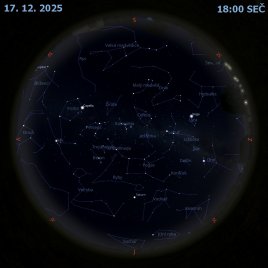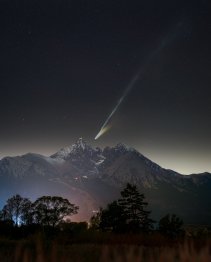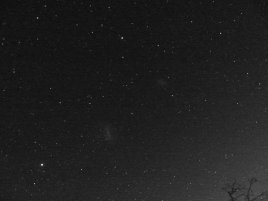Galaktický střed infračerveně

Uznání: NASA, JPL-Caltech, Spitzer Space Telescope, Susan Stolovy (SSC/Caltech) et al.; Reprocessing: Judy Schmidt
Jak vypadá střed naší Galaxie? Ve viditelném světle je střed Mléčné dráhy ukrytý mračny neprůhledného prachu a plynu. Ale na tomto úžasném pohledu infračervené kamery Spitzerova kosmického dalekohledu pronikly spoustou prachu a ukázaly hvězdy v okolí hustého středu Galaxie. Podrobný snímek ve falešných barvách je mozaikou mnoha menších záběrů a v modrých odstínech ukazuje starší chladné hvězdy. Červená a hnědá mračna prachu souvisejí s mladými horkými hvězdami v porodnicích hvězd. Úplné centrum Mléčné dráhy bylo nedávno shledáno jako schopné vzniku nových hvězd. Galaktické centrum se nachází asi 26 700 světelných roků daleko v souhvězdí Střelce (Sagittarius). Snímek v této vzdálenosti zabírá asi 900 světelných roků.
Seznam odkazů v popisu
- APOD: 2018-07-29 Cesta do středu Galaxie
- APOD: 2020-11-22 Tmavé molekulární mračno Barnard 68
- Flickr.com: Judy Schmidt: A Reprocessed Spitzer View of the Galactic Core
- NASA: Infrared Waves
- CalTech.edu: Spitzer Space Telescope - Mission Overview
- Youtube.com: The Galactic Center (Hidden Universe)
- Wikipedia: Galactic_center
- NASA: Spitzer Captures Our Galaxy's Bustling Center
- CalTech.edu: Baby Stars Finally Found in Jumbled Galactic Center
- UniverseToday.com: Astronomers Announce First Newborn Stars at Milky Way’s Core
- APOD: 2005-10-23 Ve středu Mléčné dráhy
- HawAstSoc.org: Constellations: Sagittarius -- A Centaur Archer
- IstockPhoto.com: Foto: Protahující se kočička :-)
- NASA: What Is a Light-Year?
NASA Official: Phillip Newman Specific rights apply. NASA Web Privacy Policy and Important Notices
A service of: ASD at NASA / GSFC & Michigan Tech. U.
Odkaz na originální APOD


